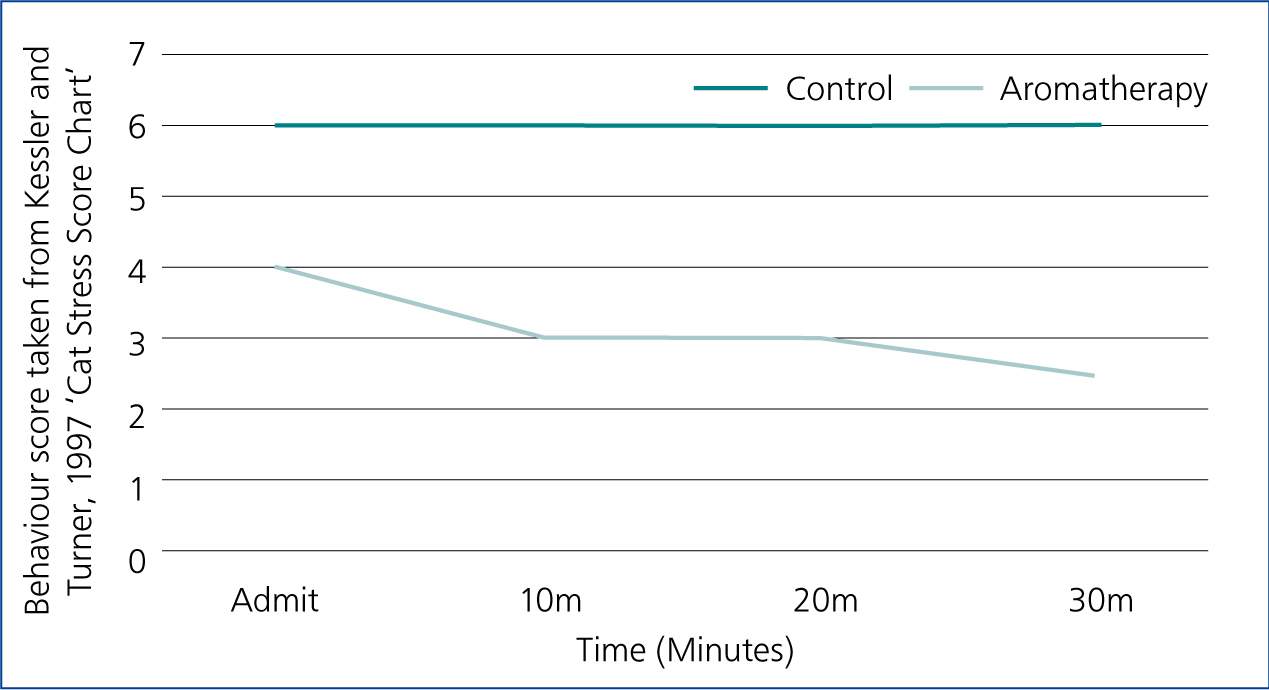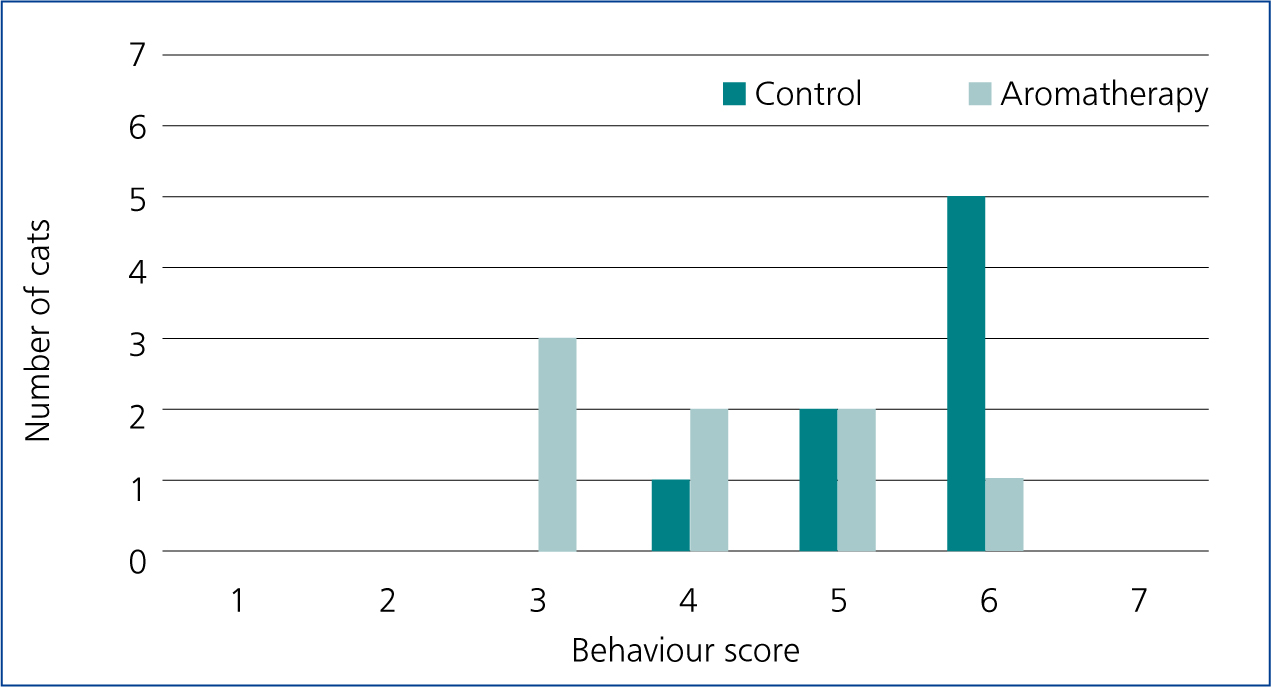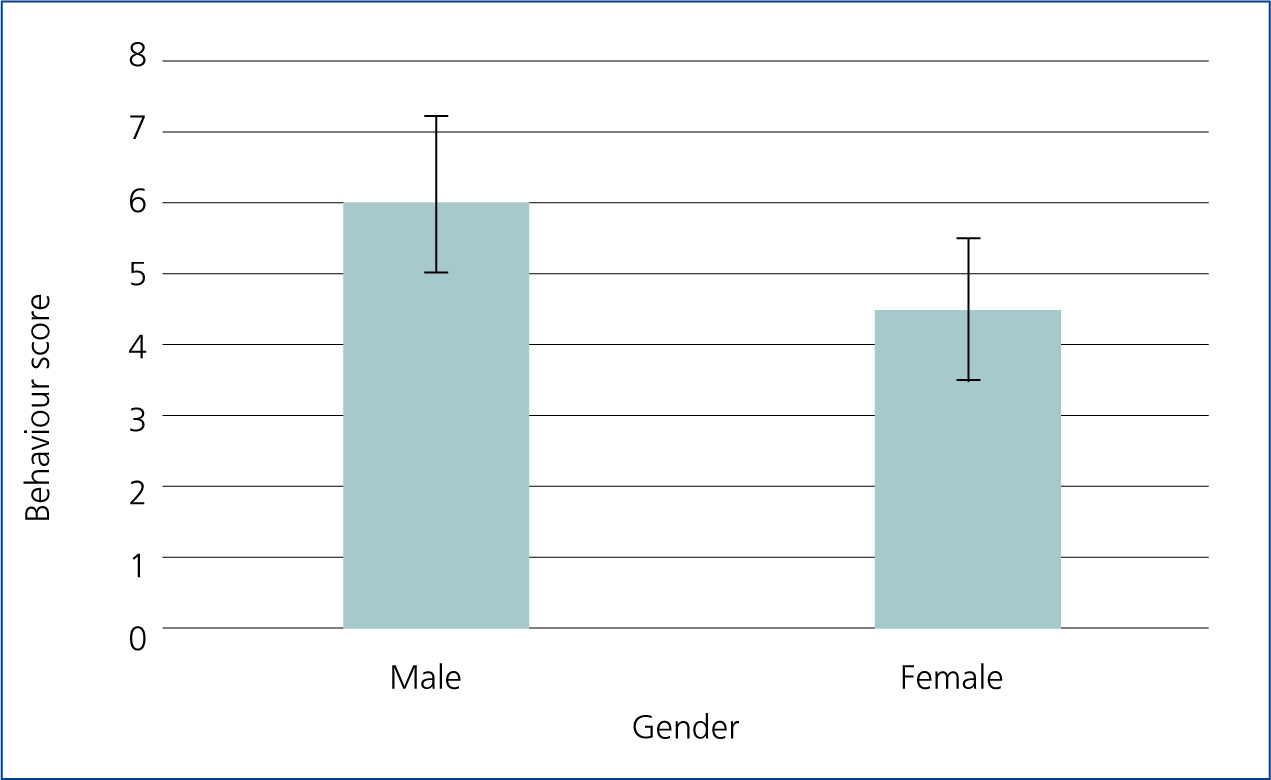Aromatherapy uses essential oils extracted from herbs and plants, to promote psychological and physical wellbeing (Fayazi et al, 2011) with different aromas thought to possess different therapeutic properties (Cooper et al, 2011). Lavender oil is thought to possess calming and anxiolytic effects in humans (Perry et al, 2012), which can help to reduce anxiety.
Aromatherapy is one of the most common complementary and alternative therapies used by health practitioners in human medicine with many positive effects observed (Fayazi et al, 2011), although its efficacy still remains controversial (Francis and Stusdal, 2014).
Anxiety can contribute to an increased recovery time within a hospitalised patient and also impact negatively on the patient's emotional state (Ellis, 2015). Riccomini (2008) suggests that even the most confident of human patients can suffer with some degree of anxiety when hospitalised. Feline patients can be very highly stressed in the veterinary environment, by extrapolating human techniques can aromatherapy using lavender oil be utilised to reduce anxiety in cats?
The aim of the study was to assess whether lavender oil could help reduce anxiety in hospitalised felines by evoking anxiolytic effects, as well as assessing the effectiveness of aromatherapy through inhalation administration.
Literature review
The veterinary environment can be stressful with the sights and smells encountered on a patient's first visit often dictating their future response (Greenfield, 2013). Recognising stress proves invaluable to ensure handling and hospitalisation of patients is as stress-free as possible (Lester, 2008). Unfortunately anxiety is common in small animals (Dobson, 2012); this is expressed through the animal's body language (Greenfield, 2013). Cats use their body language subtly which makes detecting stress difficult, although the most common sign is to create space between themselves and the stressor (Ellis, 2015).
Odours play an important role in the feline world with many practices using pheromone therapy to minimise stress (Riccomini, 2008), although studies have shown lavender oil is effective in reducing anxiety in animals (pigs, horses, dogs) (Bradshaw et al 1998; Ferguson et al, 2013; Graham et al, 2005; Wells, 2006). This leads us to examine whether aromatherapy could also be beneficial if utilised in practice (Kutlu et al, 2008). Other forms of reducing stress for felines within the veterinary practice include the use of hiding places such as a box or draped towel, raised plat-form or shelf within the kennel, as well as using heightened kennels to allow cats to feel safe and confident within their environment (Ellis, 2015).
Due to evolutionary changes, humans have limited olfaction capabilities compared with animals (Shepherd, 2004). Cats rely heavily on their sense of smell (Riccomini, 2008) and olfactory stimulation is widely accepted as a form of enrichment in captive animals (Wells and Egli, 2004), such as large felids, primates, reptiles and canids (Clarke and King, 2008). Ellis (2009) suggests olfactory stimulation can be used to promote psychological welfare and provide positive effects on patients in confined spaces.
Aromatherapy utilises the controlled use of essential oils through the olfactory system in order to maintain and assist psychological and physiological wellbeing (Mojay, 2005), and has been used for many years in human medicine (Ingraham, 1999). Lavender is commonly used in aromatherapy due to its reported relaxation and sedative affects (Kutlu et al, 2008). Random controlled trials using inhaled lavender oil with water using heat to create steam that is inhaled were conducted by Kutlu et al (2008), Kritsidima et al (2010) and Ni et al (2013) — all found reduced levels of anxiety in people. Sayorwan et al (2012) supported these findings as their trial concluded that the use of lavender not only reduces the emotional feeling of anxiety, but also the physical signs. The human participants who inhaled the lavender categorised themselves as feeling more relaxed while clinical parameters also showed reduced blood pressure within this group post lavender oil inhalation compared with participants who had inhaled almond oil. This suggests the results of this trial are reliable in assessing whether lavender oil has anxiolytic effects as the volunteers compared how they felt with the two aromas. This is in direct contrast to studies by Ndao et al (2012) and Muzzarelli et al (2006) who concluded that the use of lavender oil had no more effectiveness than the placebo in reducing anxiety. The contrasting studies could be attributed to the human belief system that aromatherapy could reduce anxiety, which may be why they found no difference between the placebo and the lavender oil; however felines do not possess this cognitive ability.
Inhalation aromatherapy is not the only form of administration (Kutlu et al, 2008). Massage, compress and baths are other common administration routes which are all used for relieving stress, anxiety and relieving tension (Kutlu et al, 2008). Lee et al (2011) compared inhalation aromatherapy with massage aromatherapy which is more commonly used in humans. Both methods reduced anxiety, but more so when massage was used. However, Lee et al (2011) questioned whether the further reduction was due to the massage itself rather than the aromatherapy. Further research is required in felines as to the benefits that may or may not occur from this technique.
Cats have a complex sense of smell and have been seen to have adverse reactions to various scents due to their inability to metabolise them (Greenfield, 2013), although research on farm animals and other companion animals has shown therapeutic effects (Yarnall and Hofve, 2009). Graham et al (2005) observed relaxed behaviours in canines when lavender oil was diffused into their kennel over 5 days. The dogs spent less time vocalising and appeared generally more relaxed. Other aromas such as rosemary and peppermint were also used in the trial, but these changes were not observed. In fact, using aromas such as rosemary and peppermint seemed to encourage the opposite effect causing dogs to stand and vocalise more and these scents are now thought to cause excitement.
Stress can sometimes be unavoidable in hospitalised patients which results in a negative experience and prolonged recovery, therefore consideration of any positive methods to help reduce stress should be the main priority of veterinary staff (Hewson, 2014), and this lead us to examine aromatherapy's potential for use within veterinary practice as long as they are not harmful or contraindicated.
Methods
Prior to the project commencing, both veterinary practice and ethical consent were obtained. Owners of patients were briefed and asked to sign consent forms. Owners were asked questions regarding any pre-existing conditions and normal behaviour within the home. Participant criteria included: that the felines were less than 1 year of age, male or female, admitted for routine neutering and that this was their first hospital admission. A total sample size of 16 felines participated. Eight cats formed the experimental group exposed to the inhalation aromatherapy and eight cats formed the control group that were not exposed to any agent.
On admission, patients in both the experimental and control groups were placed in the isolation unit alone. Using inhalation aromatherapy as the administration route, the experimental group were exposed to three drops of lavender oil in 30 ml of boiling water, as recommended by Yarnall and Hovfe (2009). Inhalation aromatherapy was chosen due to the sensitivity of the feline olfactory system (Yarnall and Hovfe, 2009) as well as the positive effects observed when used both on humans (Seo et al, 2009) and animals (Shaw et al, 2007). The patients were exposed to the inhaled lavender oil for 30 minutes. The inhalation aromatherapy was then placed in a small bowl, standing on a stool directly in front of the kennel. The size of the isolation unit was 4 m x 2 m. As the room was quite small no towel was required over the kennel to keep the steam in with the patient as the scent was quite strong. No cats displayed any distress in regards to the scent however if they had done so, they would have been immediately removed from the area. The time frame of 30 minutes was chosen because it emulated the time frame used by Shaw et al (2007) in a study on rats. During this time, behaviour observations were recorded at 10 minute intervals and scored using Kessler and Turner's (1997) ‘Cat Stress Score Chart’ which was also used in Greenfield's 2013 article. During the 30 minutes, the cats were not handled and were left undisturbed. The cat's behaviour was observed via a window in the door for both groups. Lester (2008) suggests handling can be seen as threatening so the two staff members were trained in behaviour observation and scoring, and did not enter the isolation unit in order to control for confounding variables. Statistical analyses were performed using ‘Mintab’ and graphical representation through Microsoft Excel.
Results
Behaviour observations of the cats were recorded at admission, 10 minutes, 20 minutes and 30 minute intervals post admission using Kessler and Turner's (1997) Cat Stress Score Chart. Non-parametric statistical analysis was performed as the data were not normally distributed. Results indicated statistically significant differences between the control and the experimental group (aromatherapy group) for all behaviour observation periods. Admission (Mann-Whitney U Test: w=89.5, n=8,8, p =0.0216), 10 minutes (Mann-Whitney U test: w=96.0, n=8,8, p=0.0030), 20 minutes (Mann-Whitney U Test: w=96.5, n=8,8, p=0.0029) and 30 minutes (Mann-Whitney U Test: w=99.0, n=8,8, p= 0.0011). The results show that the aromatherapy group displayed less anxious behaviour than the control group.
Figure 1 shows the median behaviour scores of the two groups during the behavioural observation period at admission, 10 minutes, 20 minutes and 30 minutes post admission. There was a significant reduction in the median behaviour scores at each interval in the experimental ‘aromatherapy’ group, as opposed to those within the control group. The control group's median behaviour score remained the same throughout the 30 minute experiment.

Figure 2 indicates that cats within the control group at admission, had a higher anxiety score at admission, than cats within the experimental group (control group n=5, stress score 6; experimental group n=1, stress score 6. Cats were selected randomly for participation in each group.

Finally, Figure 3 shows male cats also appeared to score higher at admission compared with female cats, suggesting that they were more anxious at the start of the experiment however this should be researched further to test if gender is a factor.

Discussion and limitations of the study
The use of aromatherapy has mixed reviews and opinions so no expectations of results were made. This ensured the study was approached objectively to determine the effectiveness of lavender oil administered via inhalation aromatherapy, and to assess if reported anxiolytic effects of lavender oil were effective in felines.
The results of this study did show that the median behaviour stress score of the aromatherapy group reduced at each time interval in comparison to the control group median behaviour stress score, which remained the same throughout, as shown in Figure 1. The result suggests that lavender oil may possess anxiolytic effects and appears to be effective when used in cats. Similarities can be drawn between this study and those already conducted by Graham et al (2005) and Ferguson et al (2013) where anxiolytic effects were also observed in canines and horses.
The results also suggest that inhalation aromatherapy is a hassle free mode of delivery when used with cats, which compares to similar findings from studies conducted on people (Kutlu et al, 2008; Ni et al, 2013) suggesting inhalation was the most effective method of delivery when using aromatherapy to reduce anxiety in humans.
Comparison between males and females depicts an interesting difference, although anxiety variations between genders is not applicable to this research question but suggests a starting point for further research. Questions could examine if males are more prone to anxiety and stress behaviours compared with females. Or, whether the effect of lavender varies depending on gender.
However, can the findings of this research truly represent whether lavender oil can evoke anxiolytic effects? Confounding variables were encountered during the study which could have also affected validity. Limitations of the research included small sample size and therefore not representative of the feline population as a whole. In addition, another member of staff (SVN) was required to gather data from some cats which could have potentially affected the results, although previous observations suggested limited variability between the two recorders. This is because judgement can vary between people (Kaplan and Schwartz, 1977), so completing the stress score chart during behaviour observations was subjective to each individual.
Ellis (2009) suggests that over time desensitisation of the veterinary practice can show reduced anxiety levels in felines, therefore felines under 1 year of age were used. However, Greenfield (2013) suggested that smells, sights and sounds encountered on a patient's first visit can predict future responses. Within the veterinary practice, dogs were hospitalised on the same day although in a separate kennel area. Also due to the sensitivity of the cat's olfactory system, the smell of lavender could have simply masked the odour of other animals therefore reducing the anxiety rather than the scent itself having an effect. This theory is supported by Kritsidima et al (2010). Future studies should be performed within a controlled environment to reduce these variables.
Limitations were also found using Kessler and Turner's (1997) Stress Score Chart, as behaviour descriptions were included in more than one behaviour score resulting in confusion and possible classification error by the observer. Future studies should look at adapting or creating an updated cat stress score chart.
After the study began, the effectiveness of the lavender oil to boiling water ratio (three drops of lavender oil to 30 mls of boiling water — as used by Shaw et al (2007) in rats) also came into question, due to the size difference between rats and felines. Future recommendation would be to suggest testing different strengths of lavender oil to water ratio relative to species size. In addition, a short time frame of 30 minutes was chosen as used by Shaw et al (2007) in his experiment on rats; it would be interesting to determine whether a longer time frame would have had more or less of an effect. Another consideration included the boiling water used for heating the oil. The temperature quickly dropped resulting in little steam and reducing the odour strength over time so it was lower than when first mixed. This could have been combated by placing a towel over the kennel door and the bowl to trap the steam, or alternatively aromatherapy stones and oil heaters could have been used.
Overall the results do, however, show a significant statistical difference between the aromatherapy and control group. All anxiety associated behaviours appeared to be reduced in cats taking part in this study lending weight and support to the use of aromatherapy and the therapeutic effects of lavender oil.
Conclusions and suggestions for future research
Aromatherapy may be very effective in stress management (Seo et al, 2009). The results of this study seem to support the suggestion that the use of lavender oil may reduce anxiety in cats, although Kritsidima et al (2010) suggested its use in humans only works in the short term. However, any reduction in anxiety, whether short or long term is beneficial to the patient's welfare and overall hospitalisation experience. The results suggest that aromatherapy could be utilised in veterinary practice as an alternative method of anxiety reduction to those traditionally used or alongside pheromone therapy. It could also be invaluable in improving welfare of hospitalised patients as it is also a cheap and cost-effective measure that can be quickly and easily implemented within veterinary practice and by the nursing team.
The therapeutic effects that have been observed within this study could also help reduce the scepticism that surrounds complementary and alternative therapies and give rise to the conduction of further research within this area. Future studies using aromatherapy should include use of a controlled environment and constructing an alternative stress score ethogram or chart which could reflect more accurately the emotions the patient is feeling and increase the reliability and validity of the findings.

